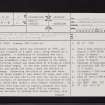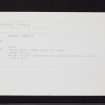Lochlea
Crannog (Prehistoric) - (Medieval), Armlet (Period Unassigned), Bead (Period Unassigned), Bowl(S) (Period Unassigned), Finger Ring (Period Unassigned), Oar(S) (Period Unassigned), Paddle(S) (Period Unassigned), Polished Axehead (Period Unassigned), Unidentified Pottery (Roman), Boat (Period Unassigned), Logboat(S) (Period Unassigned)
Site Name Lochlea
Classification Crannog (Prehistoric) - (Medieval), Armlet (Period Unassigned), Bead (Period Unassigned), Bowl(S) (Period Unassigned), Finger Ring (Period Unassigned), Oar(S) (Period Unassigned), Paddle(S) (Period Unassigned), Polished Axehead (Period Unassigned), Unidentified Pottery (Roman), Boat (Period Unassigned), Logboat(S) (Period Unassigned)
Alternative Name(s) Lochlee; Loch Lee; Loch Lea
Canmore ID 42841
Site Number NS43SE 5
NGR NS 4575 3027
Datum OSGB36 - NGR
Permalink http://canmore.org.uk/site/42841
- Council South Ayrshire
- Parish Tarbolton
- Former Region Strathclyde
- Former District Kyle And Carrick
- Former County Ayrshire
NS43SE 5 4575 3027
For logboat (Lochlea 3) found nearby, see NS43SE 10.
(NS 4575 3026) Crannog (NR) (site of)
OS 6" map (1970)
The Lochlee crannog, which was excavated in 1878, was originally situated in a small loch, being reached by a wooden gangway. A foundation of brushwood was laid, kept down by beams and stones and surmounted by clay, which was presumably clear of the surface of the water. This artificial island was stablished by driving in piles round the outer edges. In one area these piles formed two rows, one inside the other, round the outside of the crannog. Connecting the piles of inner and outer rows were thick planks of oak, about 6ft long, each with a square hole at each end to fit over the top of a pile. This structure, if continued all round the outside of the crannog, would have formed a very compact foundation. In the centre were logs laid in layers, probably the floor of a round wooden house at least 40ft in diameter. A fireplace was made by bedding flat stones in clay, with a small kerb of stones placed on edge. At least four such hearths were found, built one above the other, showing that the fireplace, and perhaps the whole house, had been reconstructed on the same site at least four times. This suggests an occupation lasting for some time, perhaps from the late first into the first quarter of the second century (J G Scott 1966).
A great many objects were found, including cup and ring-marked stones, bowls of solid timber, woodworking tools including a polished stone axe, shears, spindle whorls, a weaving comb, a snaffle-bit of Celtic type, a spiral finger ring, jet armlets; Roman material includes brooches, melon bead, 2nd century samian and fragments of coarse pottery. Most of the arifacts are in Kilmarnock Library and Museum; some are in the NMAS (Acc Nos: HT 1-5); a selection of bones from the site is in the Anatomical Museum, Oxford.
Also in 1878, prior to the excavation, workmen dug up a small dug-out canoe from the moss which had formed the bottom of the lake, about 100 yds from the crannog, then visible as a grassy mound.
R Munro 1880; 1879; A S Robertson 1970; J Curle 1932; NMAS 1892
When visited in 1954, no trace of the crannog was found in a pasture field. The published site was obtained from Munro's (1880) plan.
Visited by OS (JLD) 26 April 1954
This crannog has obviously had a multi-period occupation. Among the finds was a 9th-century ringed pin, and also objects of 16th- or 17th-century date, such as a brass mounted knife and a number of iron implements of similar date.
L Laing 1975
Munro's detailed plan indicates that the crannog measured overall some 33m E-W by 23m transversely, with its centre at NS 4574 3027. It was situated near the S shore of a loch which was some 8 hectares in size. Dick Institute Museum accession numbers: LC 21 - 682 (intermittent sequence); also, boxed items LC 140 - 146 (in sequence), LC 161 and LC 180.
Visited by OS (JRL) 26 June 1982
Hanging-escutcheon.
L Laing and J Laing 1987
Bronze spiral finger-ring of thin ribbon.
E J MacKie 1971.
Within the area of the former loch of Lochlea or Lochlee there have been found five logboats, two oars, a paddle and a crannog. The loch was situated in the rolling clayland of the Cessnock valley at an altitude of about 120m OD and was drained about 1840.
1-2 (NS c. 457 302). The initial drainage of the loch revealed two logboats, each of them about 12' (3.7m) long, 'on the south-west side of the crannog'. Their fate was not recorded.
3. (See NS43SE 10).
4. (NS 4575 3027). In 1878-9 Munro conducted excavations on the crannog. Among the objects found 'chiefly in the refuse-heap, and in the portion of debris corresponding to the area of the log pavement' he notes a 'Piece of wood like the back of a seat in a canoe'. This possible transom measures 2'4" (0.7m) in length by 9" (230mm) in breadth.
5. (NS 4575 3027). During the same excavations, Munro dug a central shaft to investigate the sub-structure of the crannog. Within the log pavement there was found 'part of a small canoe hollowed out of an oak trunk...evidently part of an old worn-out canoe...economised and used instead of a prepared log'. The surviving portion was 5' (1.5m) long and 1' (0.3m) deep; it varied in breadth between 1'2" (0.4m) broad at the end and 1'7" (0.5m) at the break. It is not recorded whether this boat was removed. The form of the boat cannot now be assessed and the incomplete nature of the remains precludes quantitative analysis.
R Munro 1880; R J C Mowat 1996.
NS 4575 3026 Lochlee crannog. An archaeological survey was undertaken in September 1996 as a part of an Environmental Assessment associated with a proposal for opencast coal mining on land around Lochlea.
Sponsor: Natural Resource Consultancy.
M Cressey and W L Finlayson, 1996.
Field Visit (March 1985)
Lochlea NS 4575 3027 NS43SE 5
Nothing is visible of a crannog situated 330m NE of Lochlea steading. The crannog was first discovered in the course of drainage operations and subsequently excavated by Munro in 1878-9. The excavations revealed that the upper part of the crannog consisted of a stratified deposit of clay, earth, stones and timber about 2.1 m deep; this deposit, which included a series of superimposed hearths, rested on a timber platform 11.9m square: A solid timber foundation went down a further 3m below the platform. The central part of the crannog appears to have been cleared down to the platform, but substantial portions of the structure beneath, and the timber gangway that approached from the SSE, are probably still intact. The finds from the excavation include objects which range in date from the 2nd century AD to the medieval period.
RCAHMS 1985, visited March 1985.
(Munro 1880, 30-88; Munro 1882, 68-151; Robertson 1970, table iii; Laing 1975, 20, 25).
























